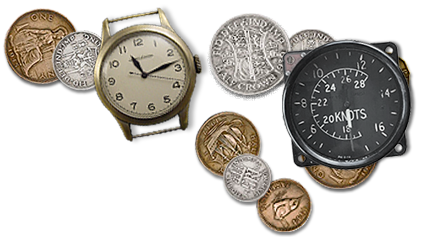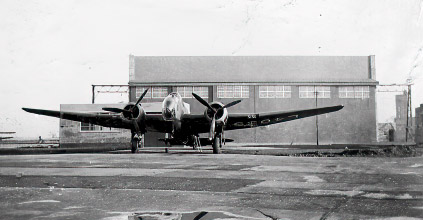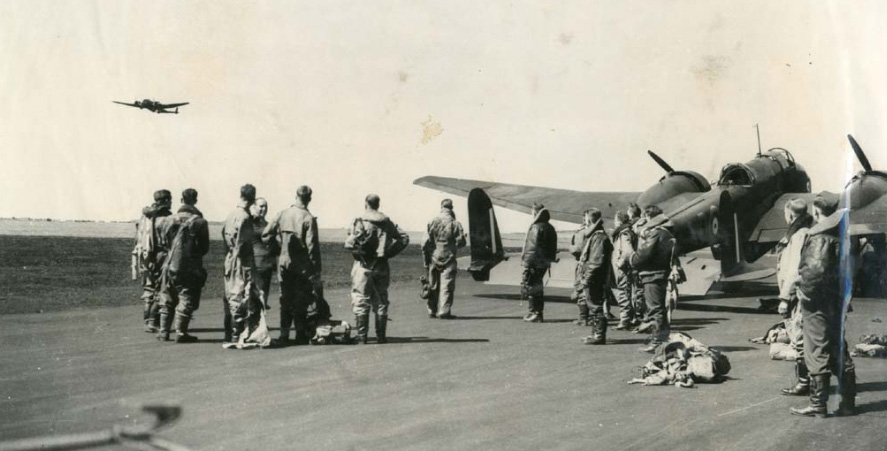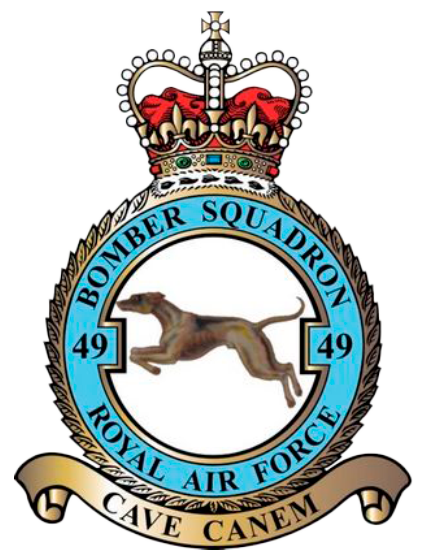WAR GRAVE
THOMAS A. KEATING (grave 36)
CORPORAL
49 SQUADRON
ABOUT MY LIFE
Born: 1893
Died: 23rd November 1939
At 46 years-old, I was very much the father figure to many on 49 Squadron, including those of higher rank. I was married to Catherine May Keating, of Winchester and my parents were Thomas and Nancy Keating. I had been a soldier in the First World War, transferring from the cavalry to the Royal Flying Corps, the predecessor of the Royal Air Force. Squadron Leader Peter Tunstall, who wrote a book about his wartime experiences and his time in the infamous Colditz Castle wrote fondly of me and these extracts from his book “The Last escaper” give a good idea of my character.
Our two future VC’s were not the only great men at Scampton. In my estimation another of them was Aircraftman Keating. To our young eyes, Keating was an old man. He had iron-grey hair and a row of First World War medal ribbons…. Keating also played rugby for the Station and died young at heart.
When an airman came up, saluted smartly and said “Excuse me sir, but AC Keating would like to have a word with you” you knew you were in for a quiet fatherly dressing-down that would really hit home.
“Now that’s not the way to go on, sir, is it now?”
“No, Keating” “I mean we’ll never really get on in the service if we do silly things like that, will we, sir?”
“Yes, Keating-I mean, no, Keating”
“Very well then, we’ll have to pull our socks up, won’t we, sir?”
And so it was with the pilot officer looking sorrowfully at his shoes in the august presence of the old Wop/AG.
Tunstall recalls asking Corporal Keating how long he had been in the service:
“Twenty-four years sir, counting the Army. Me and my brother was in the same cavalry regiment. I was there when he was killed. That’s when I transferred to the Royal Flying Corps, I wanted to belt them bloody Huns and the cavalry wasn’t much good anymore was it sir?”

MY AIRCRAFT
On the day of the accident, I was flying a Handley Page Hampden L4034 of 49 Squadron. 49 Squadron had been the first RAF unit to receive the Hampden and this particular aircraft was only one year-old. The Hampden was a medium bomber with a crew of 4. Pilot, Navigator, Wireless Operator/gunner and a further gunner. Although it was a vast improvement on the biplanes 49 Squadron had been flying just before the war opened, in reality it was already obsolete. Early daylight raids had been a disaster, the bomber was too slow to evade German fighters and its guns were no match for the Germans either. The distinctive fuselage, designed to give the aircraft a sleek, aerodynamic profile, led to the Hampden earning its nickname of “The Flying suitcase”.
Crew: 4
Span: 21.09 m
Length: 16.32 m
Height: 4.37 m
Wing area: 63.90 m²
Empty weight: 5,344 kg
Loaded weight: 8,508 kg
Engine: 2 x Bristol Pegasus XVIII 9-cylinder radial engines
Engine power: 980hp each
Maximum speed: 410 km/h
Rate of climb: 5.00 m/s
Range normal: 1,095 km
4 or 6 x 7.7mm Vickers K machine guns (1 flexible, 1 nose, 1 or 2 dorsal, 1 or 2 ventral)
1,814kg of bombs/mines or 1 x 18in torpedo

MY ROLE
At this early stage of the war, Air Gunners and Wireless Operators were not specialist aircrew roles. Instead, volunteers were sought from amongst the ground trades on the station. On this flight I was being trained to be a wireless operator. When not operating the wireless set, I manned the upper dorsal machine gun, which defended against enemy fighters attacking from the rear. The other gunner sat in a rear facing gun position in the belly of the aircraft. In the Hampden, it was common for gunners to swap these roles between flights.

MY SQUADRON

Motto: Cave Canem
Beware of the Dog
49 Squadron was formed at Dover on 15 April 1916 under the command of Major A S Barratt MC and spent its first 18 months as an aircrew training unit equipped with BE2Cs and RE7s. Other documents record that the squadron also trained using Martinsydes. In November 1917 the squadron was re equipped with DH4s and moved to La Bellevue aerodrome in France. Here the squadron was employed in the day bomber role as part of the 3rd (Army) Wing. Its first raid was made on 26 November 1917. Following the end of hostilities, the squadron was disbanded on 18 July 1919. According to its records 49 Squadron destroyed 56 enemy aircraft drove down another 63 out of control, dropped a total of 120 tons of bombs and operated from 10 airfields in France during the 1914-18 War.
On 10 February 1936, 49 Squadron re-formed at Bircham Newton from a nucleus provided by ‘C’ Flight of No 18 Squadron. It was equipped with Hawker Hind light bombers and initially commanded by Flt Lt J C Cunningham. It moved to Worthy Down in August 1936 where its official badge, depicting a racing greyhound surmounting the motto ‘Cave Canem’ (Beware of the Dog), was presented on 14 June 1937. At first the badge seems inappropriate for a bomber squadron but it is in fact indicative of the performance of the Hawker Hind when compared with its contemporaries. A move to Scampton in March 1938 was followed by conversion to the Handley Page Hampden, the first unit to be equipped with the type.
During the opening months of World War 2 the squadron was employed mainly on reconnaissance, mine laying and leaflet dropping. On 11 May 1940 bombing attacks on Germany began, the oil refineries at Munchen Gladbach being attacked. On 12 August a most successful low level attack on the Dortmund Ems canal was pressed home by Hampdens of 49 Squadron despite fierce opposition. Flt Lt R A B Learoyd received the Victoria Cross for his bravery during the attack, the first awarded in Bomber Command.
The squadron began to re equip with Manchester aircraft in April 1942; however, these aircraft were not in use for long and by July 1942 were replaced by Lancasters which, with their greater range and striking power, extended the scope of the squadron’s operations.
The Squadron stood down from 1-15 January 1943 during which time a move was made to Fiskerton. Operations resumed on 16 January when the squadron attacked Berlin the first of many such visits. For the remainder of the war the squadron continued as a front line bomber squadron and took part in most major operations by Bomber Command including, in August 1943, the vital attack on the rocket research establishment at Peenemunde when the squadron lost four of the twelve Lancasters despatched.
After moving to Fulbeck on 16 October 1944, then Syerston on 22 April 1945, the squadron made its last attack on 25 April when Berchtesgaden was the target. In May the squadron took part in Operation ‘EXODUS’ ferrying ex -prisoners of war back to the UK.
Honours and awards gained by members of 49 Squadron during the Second World War include 1 Victoria Cross, 1 Empire Gallantry Medal (later the George Cross), 7 Distinguished Service Orders, 131 Distinguished Flying Crosses, 2 Conspicuous Gallantry Medals and 105 Distinguished Flying Medals.
Following World War Two, the squadron flew Avro Lincolns and later the Vickers Valliant, the first of the V-bombers. It was in this aircraft that they would take part in the tests of Britain’s first nuclear weapons. From November 1959 the squadron reverted to the normal medium bomber role. It moved to Marham on 26 June 1961. On 5 June 1964 Her Royal Highness Princess Marina, Duchess of Kent, presented 49 Squadron with its standard, which was awarded in April.
49 Squadron was disbanded at RAF Marham on 1 May 1965, when all Valiant aircraft were withdrawn from service.
THE ACCIDENT
The 23rd November 1939 was a typical November day, cold and foggy with visibility down to just 50 yards. The weather was so bad that the Officer Commanding 49 Squadron nearly decided to cancel what was to become the fatal flight. However, the pilot was Squadron leader McGregor-Watt, trained 13 years ago as a Flight Cadet at the RAF College Cranwell, he had amassed an impressive 3000 hours flying time. No doubt the vast experience of this highly respected pilot reassured him that it was safe to allow the flight to go ahead, especially as their task was to practice landing in very poor visibility, using the ZZ landing system.
ZZ stood for zero height and zero visibility, and it was a blind approach system designed to allow the pilot to land in the poorest of weather.
The ZZ landing system involved a ground station at the landing airfield, transmitting bearings to the aircraft. The pilot could then use these bearings to calculate his position in the circuit and position the aircraft so that as he descended, the runway would appear in front of them, as they broke cloud at very low level.
On this day, Squadron leader McGregor-Watt took the aircraft to nearby RAF Waddington to conduct the practice. At around noon, disaster struck. Having apparently misjudged the approach, the aircraft was seen roaring across the airfield at very low level and not aligned anywhere close to the runway.
The aircraft banked hard to avoid the Control Tower, but was unable to avoid the hangar, just behind it. L4034 crashed through the roof of the hangar where members of 50 Squadron were at work. All on board the aircraft were killed as well as 3 members of 50 Squadron, who were killed when an engine from the aircraft struck them. Aircraftman Second Class Bastow was injured.
The subsequent Court of Enquiry established that poor positioning of the ZZ antenna had caused inaccuracies in the system and it was relocated to a more suitable position.
CASUALTIES – 23RD NOVEMBER 1939
Pilot S/L P McG Watt (Buried Nettleham)
Cp1 Thomas Keating (Buried Scampton)
AC1 Stanley Taylor (Buried Scampton) MORE
AC Kelly (Buried Scampton) MORE
On the ground
Killed:
Cpl Archibald MacDonald Henderson (Buried Waddington)
AC1 Leslie McGarvie (Buried Prestwich)
AC2 Frank Talbot (Buried Blackburn)
Injured:
AC2 M Bastow
Where Next
Visit Sqn Ldr McGregor Watt’s Grave (Link to CWGC site for Nettleham.
Visit Cpl Henderson’s Grave (Link to CWGC site for Waddington).
ON THIS DAY IN WORLD WAR TWO – 23RD NOVEMBER 1939
Finnish diplomats in Moscow, Russia made the final pleas to avoid war. At midnight, Soviet Foreign Minister Molotov ordered the invasion to commence.
British destroyers HMS Kingston, HMS Icarus, and HMS Kashmir forced German submarine U-35 to surface and surrender in the North Sea with depth charges. U-35’s crew scuttled the submarine to prevent capture.
Residents of Soviet-occupied Poland had Soviet citizenship forced on them.
